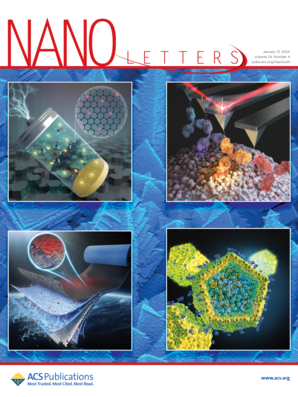Antiferrodistortive and Ferroeletric Phase Transitions in Freestanding Films of SrTiO3
IF 9.6
1区 材料科学
Q1 CHEMISTRY, MULTIDISCIPLINARY
引用次数: 0
Abstract
Thin films’ properties can be greatly influenced by their supporting growth substrates. Even in the so-called strain-free heterostructure films, it is still unclear whether there will be no interfacial electronic reconstructions induced by the underlying substrates. Here, we report the studies of SrTiO3 (STO) films in the freestanding form (FS) with a thickness ranging from 20 to 80 nm. These STO films, by default, are in a strain-free state; they exhibit distinct properties not seen in both bulk and strain-free heterostructure forms. Our films show an enhanced antiferrodistortive (AFD) phase transition temperature with a preferential in-plane rotation axis for the TiO6 octahedra. The anisotropic Ti orbital occupancy around the surface signals the departure of its properties from the bulk. Moreover, we have found that the in-plane ferroelectricity can be strengthened by the reduced dimensionality, establishing that the dimensionality control is an important factor for enhancing STO’s ferroelectric response.

SrTiO3独立薄膜中的反铁畸变和铁电相变
薄膜的性能受其支撑生长基质的影响很大。即使在所谓的无应变异质结构薄膜中,是否没有由衬底引起的界面电子重构仍然不清楚。在这里,我们报道了SrTiO3 (STO)薄膜在独立形式(FS)的研究,厚度范围从20到80 nm。默认情况下,这些STO薄膜处于无应变状态;它们表现出在体异质结构和无应变异质结构形式中所没有的独特性质。我们的薄膜显示了TiO6八面体的抗铁畸变(AFD)相变温度的增强,并且具有优先的平面内旋转轴。表面周围各向异性的钛轨道占位表明其性质与体的不同。此外,我们还发现降维可以增强STO的面内铁电性,这表明降维控制是提高STO铁电响应的重要因素。
本文章由计算机程序翻译,如有差异,请以英文原文为准。
求助全文
约1分钟内获得全文
求助全文
来源期刊

Nano Letters
工程技术-材料科学:综合
CiteScore
16.80
自引率
2.80%
发文量
1182
审稿时长
1.4 months
期刊介绍:
Nano Letters serves as a dynamic platform for promptly disseminating original results in fundamental, applied, and emerging research across all facets of nanoscience and nanotechnology. A pivotal criterion for inclusion within Nano Letters is the convergence of at least two different areas or disciplines, ensuring a rich interdisciplinary scope. The journal is dedicated to fostering exploration in diverse areas, including:
- Experimental and theoretical findings on physical, chemical, and biological phenomena at the nanoscale
- Synthesis, characterization, and processing of organic, inorganic, polymer, and hybrid nanomaterials through physical, chemical, and biological methodologies
- Modeling and simulation of synthetic, assembly, and interaction processes
- Realization of integrated nanostructures and nano-engineered devices exhibiting advanced performance
- Applications of nanoscale materials in living and environmental systems
Nano Letters is committed to advancing and showcasing groundbreaking research that intersects various domains, fostering innovation and collaboration in the ever-evolving field of nanoscience and nanotechnology.
 求助内容:
求助内容: 应助结果提醒方式:
应助结果提醒方式:


